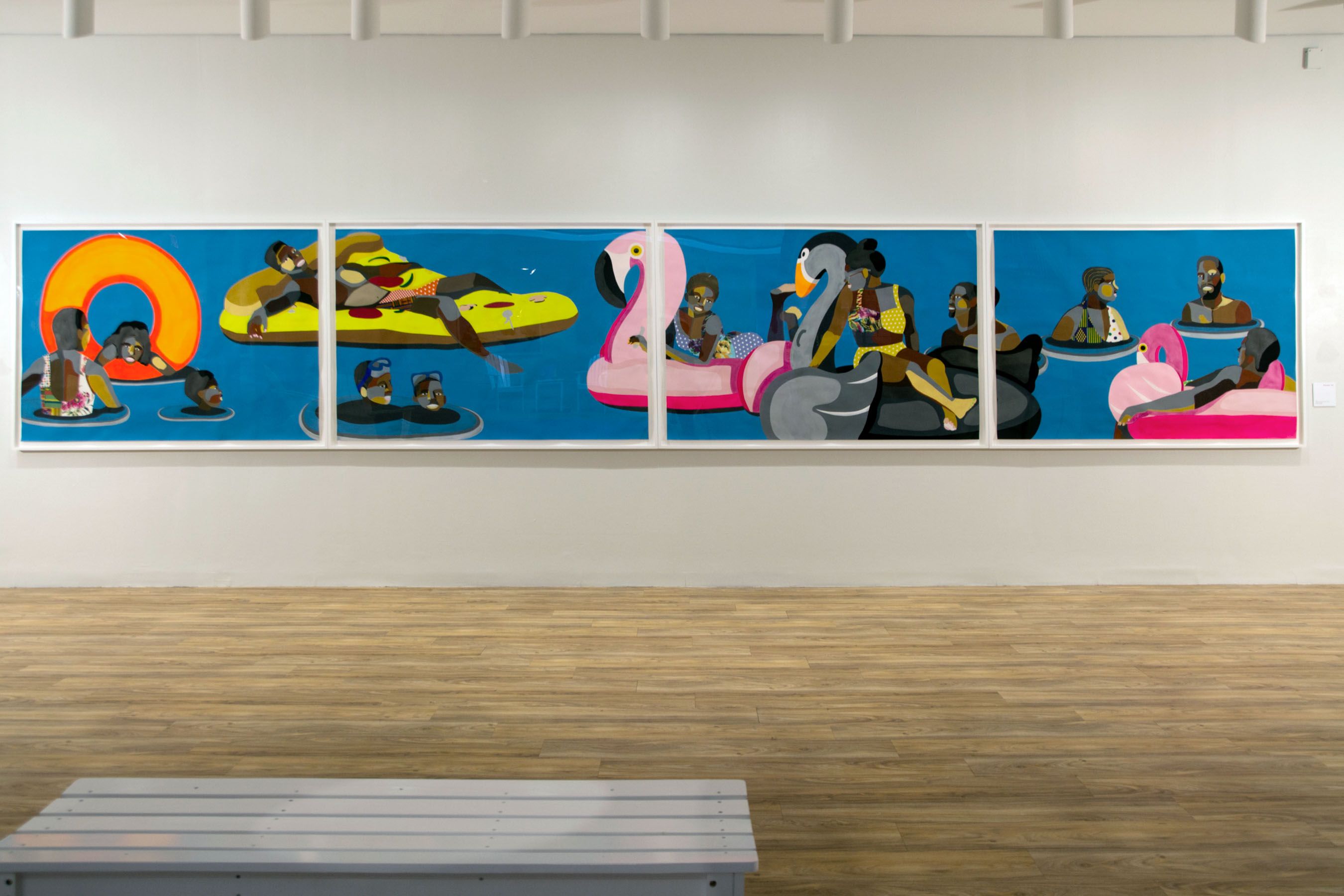
Derrick AdamsBuoyant | We Came To Party And Plan
Installation view of Buoyant / We Came to Party and Plan by Derrick Adams, March 3, 2020—August 23, 2020, Hudson River Museum, Yonkers, NY.
“Sometimes a normal social gathering can represent a radical space. I’m often inspired by the people around me at parties, and how they are making important changes to society. You can go to a social event and still get things accomplished.” — Derrick Adams
Installation Views
Derrick Adams (American, born 1970) delves deeply and fearlessly into the nooks and crannies of Black life and culture, unveiling a nuanced wholeness of humanity. The artist depicts a world where joy, love, leisure, and even prosaic normalcy play central roles, methodically filling the many voids and omissions in popular visual culture. Buoyant is the first museum exhibition of Adams’ Floaters series and debuts We Came to Party and Plan (https://www.hrm.org/exhibitions/we-came-to-party-and-plan/) (extended through October 18), new related works the artist created during his summer 2019 Rauschenberg Residency.
Executed between 2016 and 2019, the Floaters series is a collection of vividly painted portraits depicting Black people in various states of rest and play, buoyantly floating on calm waters. Relaxed bodies, some with a gentle grin, others holding a summertime beverage, melt into rainbow-colored unicorns or candy shaped plastic floaties. This classically American iconography signifies the carefree pleasures of success: the American Dream in physical form. Through Adams’ hand, and his vantage point, these archetypal images feel simultaneously familiar yet unexpected.
With the Floaters series, Adams recontextualizes this classic visual trope to create a more accurate and fuller representation of the Black lived experience. The immediacy of the imagery in these paintings invites viewers to bring their own notions to the scene and recognize moments that have too often been missing in mainstream American media.
Beyond their superficial form, Adams’ sun-soaked figures also reveal a tangle of multifaceted human complexity. They evoke nostalgic images of summer-time fun, and they may also jar some viewers into reflecting on more traumatic lived or learned histories. From the horrific journey across Atlantic waters of the Middle Passage, to the long history of segregation at America’s swimming pools and beaches, Black people’s relationship with water has not always been one of carefree joy. While Adams does not specifically focus his artistic lens on this fraught history, he fully recognizes and engages with the memories and historical trauma that can be kindled in many viewers.
Much like water, the exhibition flows to unexpected spaces. In addition to works from the Floaters series, Buoyant features an immersive, large-scale installation entitled We Came to Party and Plan, a newly created body of work that invites the viewer into a party atmosphere full of complexity, as well as Tables Turned, an earlier series also related to celebration. In other areas of the Museum, the artist curated a selection of works from the Hudson River Museum’s collection, casting a fresh perspective on historical and twentieth-century works related to the subjects of water and leisure.
Derrick Adams: Buoyant is organized by the Hudson River Museum, and co-curated by James E. Bartlett, founder of OpenArt, and Laura Vookles, Chair of the HRM’s Curatorial Department. The Museum’s unique perch along the banks of the Hudson River in Yonkers provides a particularly compelling setting to consider these images and themes. The fully illustrated catalog features essays by Bartlett and art critic and writer Antwaun Sargent, an interview between Adams and artist Mickalene Thomas, and a section dedicated to Adams’ curation of the Museum’s collections. A rich array of interdisciplinary programs, including artist and author tours, public discussions, music, spoken word performances, film, and studio workshops, accompanies the exhibition.
Learn more on The Hudson River Museum's website.